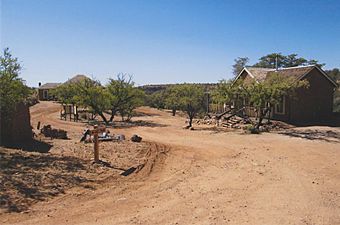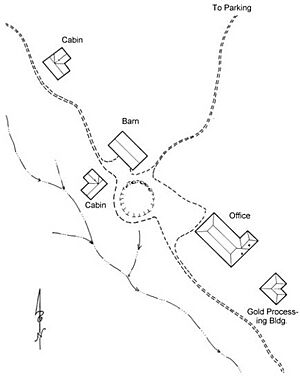Kentucky Camp, Arizona facts for kids
Quick facts for kids |
|
|
Kentucky Camp Historic District
|
|

Kentucky Camp in 2014.
|
|
| Location | Santa Rita Mountains, Arizona, USA |
|---|---|
| Nearest city | Sonoita, Arizona |
| Area | 340 acres (140 ha) |
| Built | 1905 |
| Architect | George B. McAneny; James B. Stetson |
| NRHP reference No. | 95001312 |
| Added to NRHP | November 22, 1995 |
Kentucky Camp is a ghost town and old mining camp in Pima County, Arizona, United States. It's located near the town of Sonoita and is part of the Arizona Trail. The area, known as the Kentucky Camp Historic District, was added to the National Register of Historic Places in 1995. Since it's inside the Coronado National Forest, the United States Forest Service helps take care of its old buildings.
Contents
The Story of Kentucky Camp
Kentucky Camp is a special place today, filled with mesquite trees, oaks, tall grasses, and cacti. But it almost didn't happen! A strange accident actually helped save it. The original plans for finding gold here were very big, but they never fully came true.
Gold Rush in the Mountains
In 1874, people found gold on the eastern side of the Santa Rita Mountains. This area became known as the Greaterville mining district. It turned out to be one of the richest places for gold in southern Arizona.
Gold found here was in "placer deposits." This means gold was mixed with sand and gravel. To get the gold out, miners needed water to wash the mixture. However, the streams, called arroyos, in the Santa Rita Mountains were usually dry.
Miners had to carry heavy bags of dirt to the few running streams. Sometimes, they even carried water in canvas or goatskin bags on donkeys to their mining spots. By 1886, most of the easy-to-find gold was gone, and many miners left.
A Big Idea for Water
In 1902, a mining engineer from California named James Stetson had a clever idea. He wanted to collect rainwater from mountain streams in a large tank, called a reservoir. This reservoir would hold enough water to keep a mine working for ten months!
Stetson convinced a rich man from California, George McAneny, to invest in his plan. Other investors from Tucson also joined. Together, they formed the Santa Rita Water and Mining Company.
They searched the Greaterville area and chose a mining spot in Boston Gulch. Their main office and homes for workers were set up at nearby Kentucky Gulch. From 1902 to 1906, the buildings at Kentucky Camp were busy with mining operations. By mid-1904, their water system was ready, and they were using water to mine for gold at Kentucky Camp.
A Sudden End to Mining
In 1905, just before a big meeting with investors, something sad happened. James Stetson died in a fall from a window at the Santa Rita Hotel in Tucson.
His partner, George McAneny, faced money problems and health issues. Even though other partners tried to keep the mining going, Kentucky Camp was eventually left empty by 1912.
What Happened After 1912?
An attorney for the McAneny family bought the buildings and land. For many years, until the 1960s, the land was used as a cattle ranch.
In the 1960s, the land was sold to a mining company called ANAMAX Mining. Then, in 1989, the United States Forest Service bought the land. They added it to the Coronado National Forest.
Today, the Forest Service works with volunteers to protect and share the history of Kentucky Camp. It helps us understand what mining life was like in the American West.
Kentucky Camp Today
The U.S. Forest Service took over Kentucky Camp in 1989. Since then, it has been part of the Coronado National Forest. The Forest Service is working to save the old buildings and teach people about mining camp life.
The Buildings That Remain
Today, there are five old adobe buildings at Kentucky Camp. They were built around 1904. The largest building was probably the main office for the Santa Rita Water and Mining Company. Later, it became the main house for the cattle ranch.
A smaller building behind the main office was used to test gold samples. This is known because of special liners found from an assay furnace, which was used to process gold. Across from a small house, where James Stetson might have lived, are the remains of an old barn. Another small adobe house stands at the far end of the site.
Saving History: Preservation Efforts
Work to preserve Kentucky Camp started in 1991. The Forest Service has worked hard to make the remaining buildings stable. This includes fixing roofs and walls to stop them from falling apart.
Many volunteers have helped with this work through a program called Passport In Time. The Friends of Kentucky Camp group also helps a lot.
When the U.S. Forest Service got the property, the buildings were in very bad shape. The roofs needed to be fixed first. This was important to stop water from damaging the old adobe walls. A generous donation of $10,000 helped make this project possible. This money came from the people who made the TV show The Young Riders, which was filmed nearby from 1989 to 1992.
As of 2005, the Forest Service planned to make the buildings look like they did during the mining era.
Gallery











